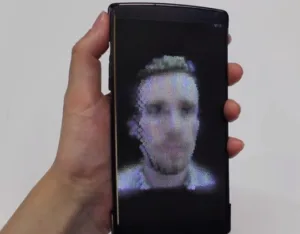Differentiation is a struggle in today’s smartphone market. The form factor has matured and there has been no ‘killer app’ technology for several years. Flexible displays, like LG’s G Flex, have had a lukewarm reception.
The Human Media Lab of Queen’s University (Canada), however, has developed a smartphone using a flexible plastic OLED display and a layer of microlenses that create a lightfield – i.e. holographic – display. The ‘Holoflex’ is capable of rendering 3D images with motion parallax and stereoscopy to multiple users simultaneously, without glasses or head tracking.
The OLED touchscreen has 1920 x 1080 resolution (OLED-Info speculates that it uses the same panel as LG’s G Flex 2) and is covered with a 3D-printed flexible microlens array. These 12-pixel wide circular blocks (16,640 of them) render a full view of a 3D object from a specified viewpoint. Image resolution is 160 x 104. Users can inspect an object by rotating the phone.
Each lens projects the 12-pixel-wide circular area directly underneath it to users. Each image block contains information about the scene from a virtual camera position that is unique to the position of the lens. Together, they present a 3D image over a field of view of about 35°.
Queen’s University has built on its earlier work on the ReFlex concept (‘Flip’ Through Pages With Active Haptic Feedback). The Holoflex uses a similar bend sensor, so that users can control apps by bending the phone. A video (found at http://tinyurl.com/zptqasl and at the bottom of this article) shows a 3D version of Angry Birds being played using this feature.
The phone uses a 1.5GHz Qualcomm Snapdragon 810 processor running Android 5.1; 2GB of RAM; and an Adreno 430 GPU.

